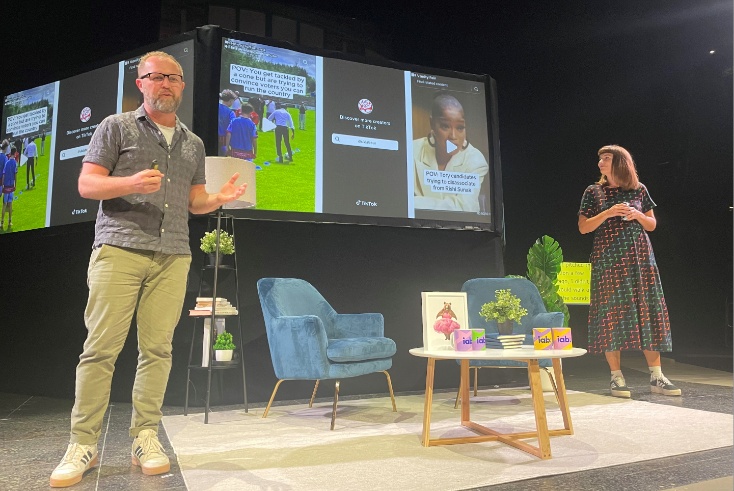Brands need to ’embrace the weird’

Brands need to embrace “the weird” and avoid a one-size-fits-all approach to appeal to consumers.
A key theme of IAB Engage this year is bringing more “joy” and creativity to digital advertising.
In that vein, EssenceMediacom’s chief strategy officer, Geoff de Burca, and head of creative strategy, Lindsey Jordan, made the case for why brands should tap into “the weird” of digital communities and be more “multi-hyphenated”.
Why be weird?
De Burca and Jordan kicked off by sharing “the perfect introduction”: the recent Labour TikTok video featuring a Cilla Black meme linked to the Conservatives’ national service policy.
It was surprising, spoken about a lot on social media and “just a bit weird”. While it had also been “quite polarising”, de Burca stressed that the film was “driving an emotional reaction”.
He explained: “We know emotional responses are things that make advertising work. This is a rallying cry today for being a bit more creative, because so much advertising is trying so hard to do things right, to conform to category conventions, to be rationally getting across the right messages, that actually they all look a bit the same. By trying so hard not to offend anyone, they appeal to no-one.”
Jordan continued that argument, highlighting digital ads that were “playing it safe to the middle ground”.
She said: “As people, we are not one-size-fits-all. We are messy. We are multifaceted and multi-hyphenated humans. We build our identity by being into a multitude of things, some of them every day, some of them weird, some of them wonderful, and everything in-between.”
To prove this point, de Burca and Jordan showed their latest “explore” pages on Instagram and TikTok to the audience — content included “extreme dishwashing”, hiking and cooking videos for de Burca; Married at First Sight Australia, breakdancing and Dwayne “The Rock” Johnson for Jordan.
Indeed, 76% of the UK belong to “a digital subculture or community”, according to Jordan, meaning this is not small or niche, but “the new mass media”.
She added: “We have multi-hyphenated people who are into a multitude of things, so brands need to be multi-hyphenated too. They need to not do one-size-fits-all; they need to think about how they help us embrace ourselves as multi-hyphenated people. They need to embrace the joy of the weird and the wonderful.”
Doing weird right
Four brands were singled out as “embracing the joy of the weird”: RSPB, Currys, Burberry and Tesco.
While de Burca said some of the social videos, which mostly used memes and short-form comedy skits, may seem like “one-off tactical stunts”, they were leaning in to “being weird” and are experiencing “significant increases in engagement”.
He explained: “When you’re being weird on a platform where the content itself is driven by the whole human diversity, the richness of being multifaceted, strange humans, that kind of content works.”
Four rules
The pair outlined four rules for brands to “embrace your weird”.
First, “be clear on your brand’s DNA and their distinct memory structure”. As an example, TikTok videos from Tesco, an EssenceMediacom client, may seem “a little bit random”, but they all lean on the supermarket’s long-held slogan, “Every little helps”. All of Tesco’s communications are about the helpfulness of Club Card prices, but done in a humorous tone of voice that Tesco has used for many years.
“There is something in there that still has, at its core, the truth of the brand. It’s just the brand expressing themselves in a slightly different way to what you might normally be seeing. Just as we have our on-stage self, we also have our multi-varied personalities — and brands can have that too,” de Burca said.
Second, embrace testing, failing and learning — especially in the digital space, where campaigns can be started more cheaply and it’s OK to fail and learn.
Third, work with co-creators like influencers who are already in those communities and subcultures. Jordan noted that research found 68% of the UK trusted creators and influencers more than brands, so it was important for brands to think about how to leverage that.
Finally, be prepared to “let it go”.
Jordan explained: “It might go somewhere you didn’t expect it to, but the number-one type of content in the world is UGC [user-generated content]. You have to be prepared to let your content go and let consumers do with it what they want, which can be quite scary.”
This kind of content, she emphasised, was “distinctly human” and not something that AI could make.
De Burca concluded: “Embrace the joy of the weird, do not fall victim to being bland, to being safe. Digital is a place where you can be weird and embrace the response that you’ll get.”



